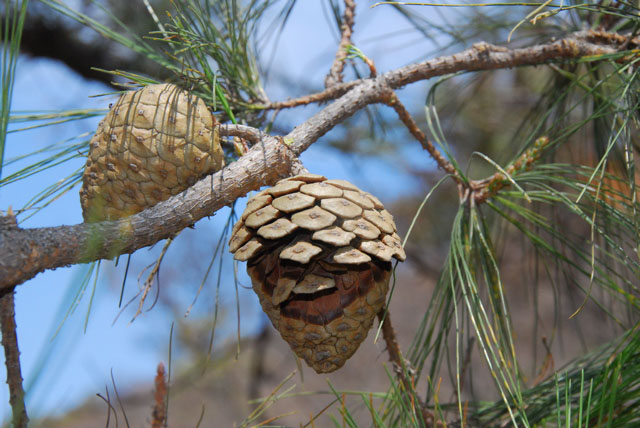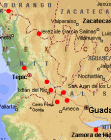
A tree in habitat, Magdalena, Jalisco [Jeff Bisbee].

Another tree in habitat, west of Quemada, Jalisco [Jeff Bisbee].

Closed cones on a tree west of Quemada, Jalisco [Jeff Bisbee].

Bark on a tree west of Quemada, Jalisco [Jeff Bisbee].

Illustration of principal features (Figure 1 from Styles and McVaugh 1990) [Rosemary Wise].

Range of Pinus praetermissa (Farjon & Styles 1997). Basemap from Expedia Maps.

Pinus praetermissa
Styles & McVaugh 1990
Common names
Ocote.
Taxonomic notes
Pinus praetermissa, initially recognized as a variety of P. oocarpa, is still recognized as the closest relative to that taxon based on multiple lines of DNA-based evidence (Hernández-León et al. 2013, Gernandt et al. 2018).
Type: Colomas, Sinaloa, Rose 1755 (Styles and McVaugh 1990).
Synonym: Pinus oocarpa var. microphylla Shaw 1909 (Farjon and Styles 1997).
Description
Trees 12-15(-20) m tall and 30 cm dbh. Branchlets flexible, slender, reddish brown, 2-4.5 mm thick. Leaves in fascicles of 5, 8-16 cm long, 0.5-0.7 mm wide, light green, ascending on the branchlets, minutely serrulate; stomata on all faces; fascicle sheaths persistent, 11-14 mm long, light reddish brown greying with age. Immature cones "almost exactly simulating those of Pinus oocarpa;" broadly ovoid and short-acute, symmetrical, light brown, smooth or sometimes with protuberant apophyses, 5.5-7 cm long on peduncles 3-3.5 cm long and 3-4 mm thick; cones opening widely, so about as long as wide. Cone scales not crowded toward the base (as in P. oocarpa) but more uniformly spreading-ascending or recurved: up to ca. 25 of the small basal scales persistent on the peduncle when the cone falls, leaving a
scar up to 3 cm across at the base of the cone: seed-wing thickened (1-1.5 mm thick) above the base (Styles and McVaugh 1990).
Distribution and Ecology
Mexico: Durango, Jalisco, Nayarit, and Sinaloa, at elevations of 900 to 1900 m. Climate is seasonal, dry from November to May, with 1000-1500 mm annual precipitation (Farjon 2010). Habitat is open woodland, pine-oak forest or tropical deciduous forest (Styles and McVaugh 1990). Common associates include P. devoniana, P. lumholtzii, and P. pseudostrobus (Farjon 2010).
Zone 9 (cold hardiness limit between -6.6°C and -1.1°C) (Bannister and Neuner 2001).
Remarkable Specimens
Ethnobotany
Since this species typically does not occur in pure stands and generally resembles P. oocarpa, it is not recognized as distinct when harvested for timber. No specific uses are known. It is not known in horticulture, though collections can be found at a few botanical gardens (Farjon 2010).
Observations
Remarks
The epithet means "overlooked;" although this species had previously been collected, it had not been recognized as a distinct taxon (Farjon 2010).
Citations
Bannister, P. and G. Neuner. 2001. Frost resistance and the distribution of conifers. P. 3-22 in F. J. Bigras and S. J. Colombo (eds.), Conifer Cold Hardiness. Dordrecht: Kluwer Academic Publishers.
Farjon, Aljos. 2010. A Handbook of the World's Conifers. Leiden, Netherlands: Brill Academic Publishers.
Farjon, A., and B. T. Styles. 1997. Pinus (Pinaceae). Flora Neotropica Monograph 75. New York, NY: The New York Botanical Garden.
Gernandt, D. S., X. Aguirre Dugua, A. Vázquez‐Lobo, A. Willyard, A. Moreno Letelier, J. A. Pérez de la Rosa, D. Piñero, and A. Liston. 2018. Multi‐locus phylogenetics, lineage sorting, and reticulation in Pinus subsection Australes. American Journal of Botany 105:711–725.
Hernández-León, Sergio, David S. Gernandt, Jorge A. Pérez de la Rosa, and Lev Jardón-Barbolla. 2013.07.30. Phylogenetic relationships and species delimitation in Pinus section Trifoliae inferrred from plastid DNA. PLOS One DOI: 10.1371/journal.pone.0070501, accessed 2013.12.28.
Styles, B. T. and R. McVaugh. 1990. A Mexican pine promoted to specific status: Pinus praetermissa. Contr. Univ. Mich. Herb. 17:307-312. Available: biodiversitylibrary.org/page/12875306, accessed 2019.02.25.
See also






